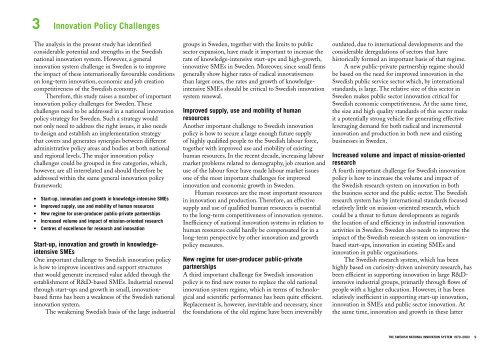The Swedish National Innovation System 1970-2003 - Vinnova
The Swedish National Innovation System 1970-2003 - Vinnova
The Swedish National Innovation System 1970-2003 - Vinnova
Create successful ePaper yourself
Turn your PDF publications into a flip-book with our unique Google optimized e-Paper software.
3 <strong>Innovation</strong> Policy Challenges<br />
<strong>The</strong> analysis in the present study has identified<br />
considerable potential and strengths in the <strong>Swedish</strong><br />
national innovation system. However, a general<br />
innovation system challenge in Sweden is to improve<br />
the impact of these internationally favourable conditions<br />
on long-term innovation, economic and job creation<br />
competitiveness of the <strong>Swedish</strong> economy.<br />
<strong>The</strong>refore, this study raises a number of important<br />
innovation policy challenges for Sweden. <strong>The</strong>se<br />
challenges need to be addressed in a national innovation<br />
policy strategy for Sweden. Such a strategy would<br />
not only need to address the right issues, it also needs<br />
to design and establish an implementation strategy<br />
that covers and generates synergies between different<br />
administrative policy areas and bodies at both national<br />
and regional levels. <strong>The</strong> major innovation policy<br />
challenges could be grouped in five categories, which,<br />
however, are all interrelated and should therefore be<br />
addressed within the same general innovation policy<br />
framework:<br />
• Start-up, innovation and growth in knowledge-intensive SMEs<br />
• Improved supply, use and mobility of human resources<br />
• New regime for user-producer public-private partnerships<br />
• Increased volume and impact of mission-oriented research<br />
• Centres of excellence for research and innovation<br />
Start-up, innovation and growth in knowledgeintensive<br />
SMEs<br />
One important challenge to <strong>Swedish</strong> innovation policy<br />
is how to improve incentives and support structures<br />
that would generate increased value added through the<br />
establishment of R&D-based SMEs. Industrial renewal<br />
through start-ups and growth in small, innovationbased<br />
firms has been a weakness of the <strong>Swedish</strong> national<br />
innovation system.<br />
<strong>The</strong> weakening <strong>Swedish</strong> basis of the large industrial<br />
groups in Sweden, together with the limits to public<br />
sector expansion, have made it important to increase the<br />
rate of knowledge-intensive start-ups and high-growth,<br />
innovative SMEs in Sweden. Moreover, since small firms<br />
generally show higher rates of radical innovativeness<br />
than larger ones, the rates and growth of knowledgeintensive<br />
SMEs should be critical to <strong>Swedish</strong> innovation<br />
system renewal.<br />
Improved supply, use and mobility of human<br />
resources<br />
Another important challenge to <strong>Swedish</strong> innovation<br />
policy is how to secure a large enough future supply<br />
of highly qualified people to the <strong>Swedish</strong> labour force,<br />
together with improved use and mobility of existing<br />
human resources. In the recent decade, increasing labour<br />
market problems related to demography, job creation and<br />
use of the labour force have made labour market issues<br />
one of the most important challenges for improved<br />
innovation and economic growth in Sweden.<br />
Human resources are the most important resources<br />
in innovation and production. <strong>The</strong>refore, an effective<br />
supply and use of qualified human resources is essential<br />
to the long-term competitiveness of innovation systems.<br />
Inefficiency of national innovation systems in relation to<br />
human resources could hardly be compensated for in a<br />
long-term perspective by other innovation and growth<br />
policy measures.<br />
New regime for user-producer public-private<br />
partnerships<br />
A third important challenge for <strong>Swedish</strong> innovation<br />
policy is to find new routes to replace the old national<br />
innovation system regime, which in terms of technological<br />
and scientific performance has been quite efficient.<br />
Replacement is, however, inevitable and necessary, since<br />
the foundations of the old regime have been irreversibly<br />
outdated, due to international developments and the<br />
considerable deregulations of sectors that have<br />
historically formed an important basis of that regime.<br />
A new public-private partnership regime should<br />
be based on the need for improved innovation in the<br />
<strong>Swedish</strong> public service sector which, by international<br />
standards, is large. <strong>The</strong> relative size of this sector in<br />
Sweden makes public sector innovation critical for<br />
<strong>Swedish</strong> economic competitiveness. At the same time,<br />
the size and high quality standards of this sector make<br />
it a potentially strong vehicle for generating effective<br />
leveraging demand for both radical and incremental<br />
innovation and production in both new and existing<br />
businesses in Sweden.<br />
Increased volume and impact of mission-oriented<br />
research<br />
A fourth important challenge for <strong>Swedish</strong> innovation<br />
policy is how to increase the volume and impact of<br />
the <strong>Swedish</strong> research system on innovation in both<br />
the business sector and the public sector. <strong>The</strong> <strong>Swedish</strong><br />
research system has by international standards focused<br />
relatively little on mission-oriented research, which<br />
could be a threat to future developments as regards<br />
the location of and efficiency in industrial innovation<br />
activities in Sweden. Sweden also needs to improve the<br />
impact of the <strong>Swedish</strong> research system on innovationbased<br />
start-ups, innovation in existing SMEs and<br />
innovation in public organisations.<br />
<strong>The</strong> <strong>Swedish</strong> research system, which has been<br />
highly based on curiosity-driven university research, has<br />
been efficient in supporting innovation in large R&Dintensive<br />
industrial groups, primarily through flows of<br />
people with a higher education. However, it has been<br />
relatively inefficient in supporting start-up innovation,<br />
innovation in SMEs and public sector innovation. At<br />
the same time, innovation and growth in these latter<br />
THE SWEDISH NATIONAL INNOVATION SYSTEM <strong>1970</strong>–<strong>2003</strong> 9

















